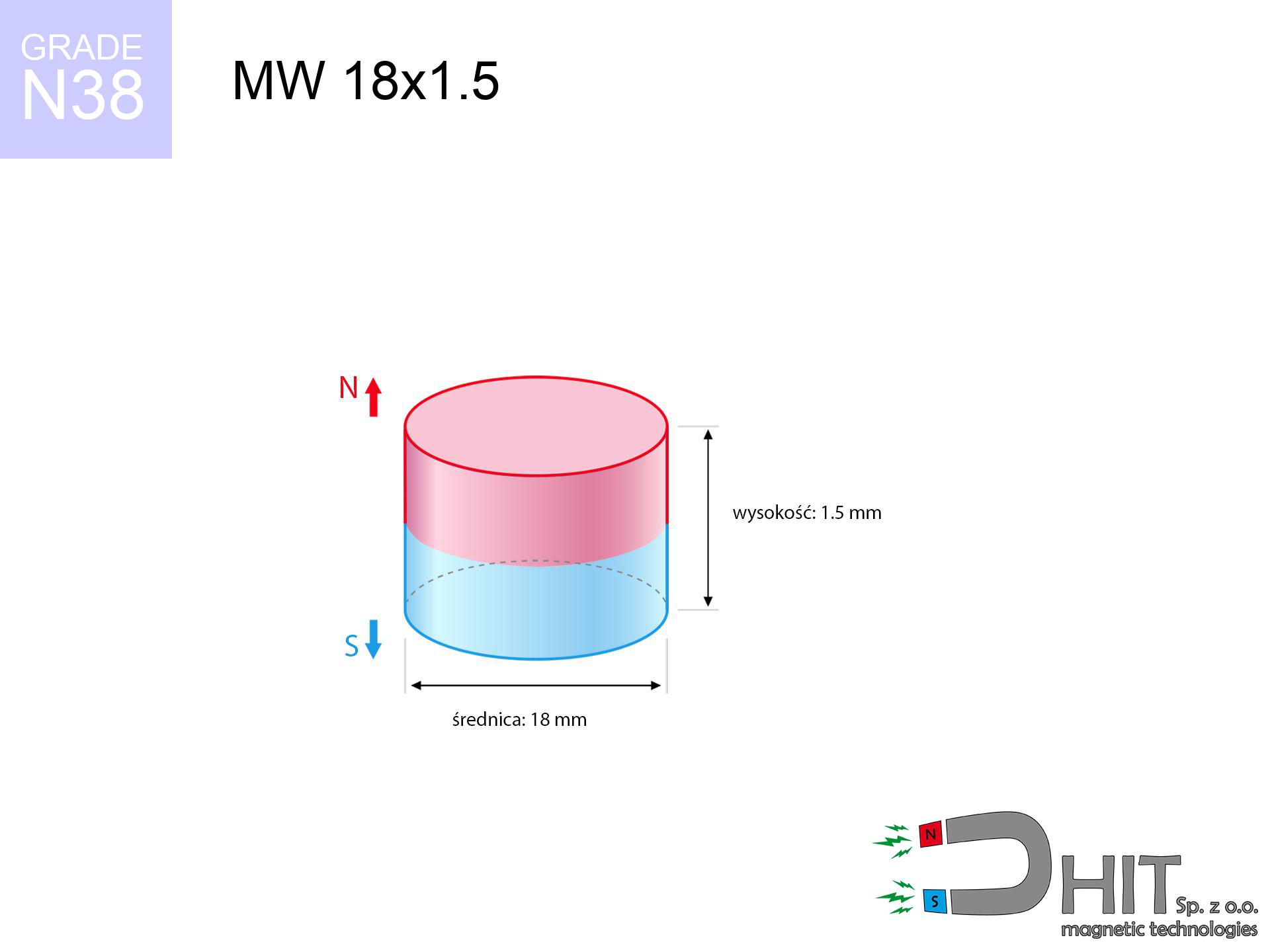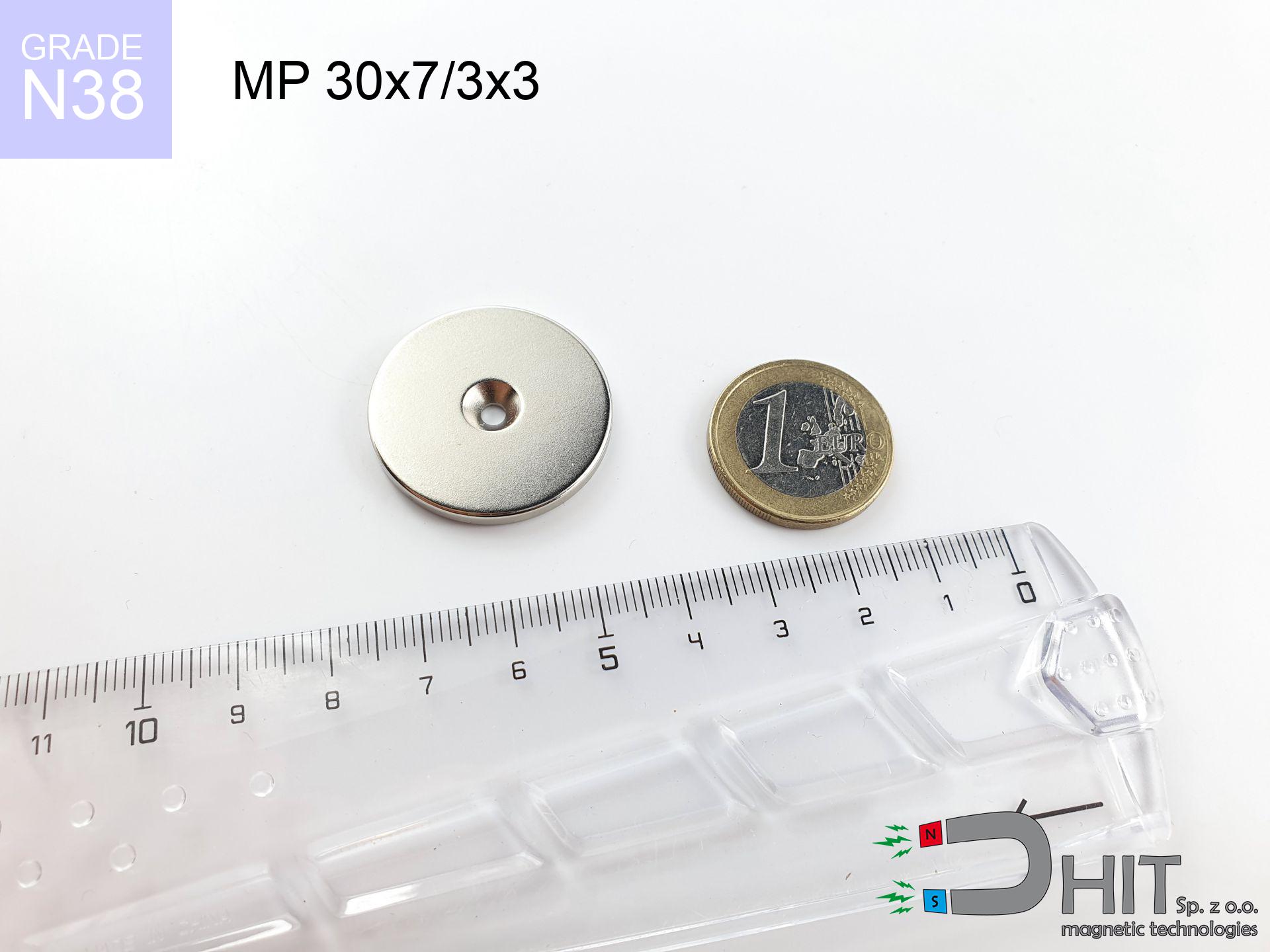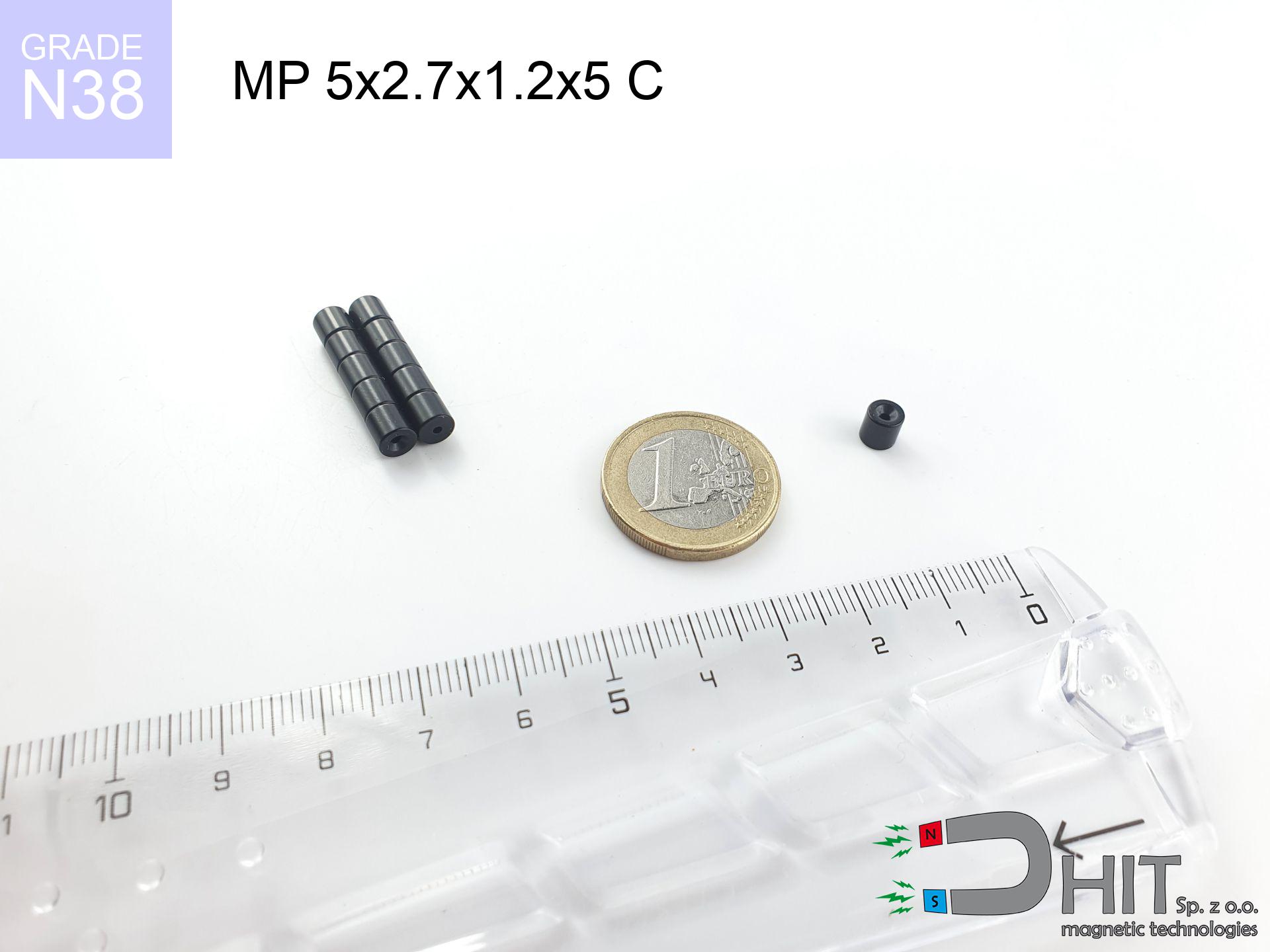MW 18x1.5 / N38 - cylindrical magnet
cylindrical magnet
Catalog no 010037
GTIN: 5906301810360
Diameter Ø
18 mm [±0,1 mm]
Height
1.5 mm [±0,1 mm]
Weight
2.86 g
Magnetization Direction
↑ axial
Load capacity
0.72 kg / 7.11 N
Magnetic Induction
101.91 mT
Coating
[NiCuNi] Nickel
1.353 ZŁ with VAT / pcs + price for transport
1.100 ZŁ net + 23% VAT / pcs
bulk discounts:
Need more?Not sure about your choice?
Give us a call
+48 888 99 98 98
otherwise get in touch by means of
form
our website.
Force along with shape of a magnet can be verified with our
magnetic calculator.
Orders placed before 14:00 will be shipped the same business day.
MW 18x1.5 / N38 - cylindrical magnet
Specification / characteristics MW 18x1.5 / N38 - cylindrical magnet
| properties | values |
|---|---|
| Cat. no. | 010037 |
| GTIN | 5906301810360 |
| Production/Distribution | Dhit sp. z o.o. |
| Country of origin | Poland / China / Germany |
| Customs code | 85059029 |
| Diameter Ø | 18 mm [±0,1 mm] |
| Height | 1.5 mm [±0,1 mm] |
| Weight | 2.86 g |
| Magnetization Direction | ↑ axial |
| Load capacity ~ ? | 0.72 kg / 7.11 N |
| Magnetic Induction ~ ? | 101.91 mT |
| Coating | [NiCuNi] Nickel |
| Manufacturing Tolerance | ±0.1 mm |
Magnetic properties of material N38
| properties | values | units |
|---|---|---|
| remenance Br [Min. - Max.] ? | 12.2-12.6 | kGs |
| remenance Br [Min. - Max.] ? | 1220-1260 | T |
| coercivity bHc ? | 10.8-11.5 | kOe |
| coercivity bHc ? | 860-915 | kA/m |
| actual internal force iHc | ≥ 12 | kOe |
| actual internal force iHc | ≥ 955 | kA/m |
| energy density [Min. - Max.] ? | 36-38 | BH max MGOe |
| energy density [Min. - Max.] ? | 287-303 | BH max KJ/m |
| max. temperature ? | ≤ 80 | °C |
Physical properties of sintered neodymium magnets Nd2Fe14B at 20°C
| properties | values | units |
|---|---|---|
| Vickers hardness | ≥550 | Hv |
| Density | ≥7.4 | g/cm3 |
| Curie Temperature TC | 312 - 380 | °C |
| Curie Temperature TF | 593 - 716 | °F |
| Specific resistance | 150 | μΩ⋅Cm |
| Bending strength | 250 | Mpa |
| Compressive strength | 1000~1100 | Mpa |
| Thermal expansion parallel (∥) to orientation (M) | (3-4) x 106 | °C-1 |
| Thermal expansion perpendicular (⊥) to orientation (M) | -(1-3) x 10-6 | °C-1 |
| Young's modulus | 1.7 x 104 | kg/mm² |
Technical simulation of the assembly - technical parameters
These data represent the direct effect of a engineering calculation. Results rely on models for the material NdFeB. Actual performance may deviate from the simulation results. Use these data as a supplementary guide for designers.
MW 18x1.5 / N38
| Distance (mm) | Induction (Gauss) / mT | Pull Force (kg) | Risk Status |
|---|---|---|---|
| 0 mm |
1019 Gs
101.9 mT
|
0.72 kg / 720.0 g
7.1 N
|
safe |
| 1 mm |
975 Gs
97.5 mT
|
0.66 kg / 658.8 g
6.5 N
|
safe |
| 2 mm |
902 Gs
90.2 mT
|
0.56 kg / 564.4 g
5.5 N
|
safe |
| 5 mm |
619 Gs
61.9 mT
|
0.27 kg / 265.7 g
2.6 N
|
safe |
| 10 mm |
274 Gs
27.4 mT
|
0.05 kg / 52.1 g
0.5 N
|
safe |
| 15 mm |
126 Gs
12.6 mT
|
0.01 kg / 11.1 g
0.1 N
|
safe |
| 20 mm |
65 Gs
6.5 mT
|
0.00 kg / 2.9 g
0.0 N
|
safe |
| 30 mm |
23 Gs
2.3 mT
|
0.00 kg / 0.4 g
0.0 N
|
safe |
| 50 mm |
6 Gs
0.6 mT
|
0.00 kg / 0.0 g
0.0 N
|
safe |
MW 18x1.5 / N38
| Surface type | Friction coefficient / % Mocy | Max load (kg) |
|---|---|---|
| Raw steel |
µ = 0.3
30% Nominalnej Siły
|
0.22 kg / 216.0 g
2.1 N
|
| Painted steel (standard) |
µ = 0.2
20% Nominalnej Siły
|
0.14 kg / 144.0 g
1.4 N
|
| Oily/slippery steel |
µ = 0.1
10% Nominalnej Siły
|
0.07 kg / 72.0 g
0.7 N
|
| Magnet with anti-slip rubber |
µ = 0.5
50% Nominalnej Siły
|
0.36 kg / 360.0 g
3.5 N
|
MW 18x1.5 / N38
| Steel thickness (mm) | % power | Real pull force (kg) |
|---|---|---|
| 0.5 mm |
|
0.07 kg / 72.0 g
0.7 N
|
| 1 mm |
|
0.18 kg / 180.0 g
1.8 N
|
| 2 mm |
|
0.36 kg / 360.0 g
3.5 N
|
| 5 mm |
|
0.72 kg / 720.0 g
7.1 N
|
| 10 mm |
|
0.72 kg / 720.0 g
7.1 N
|
MW 18x1.5 / N38
| Ambient temp. (°C) | Power loss | Remaining pull | Status |
|---|---|---|---|
| 20 °C | 0.0% |
0.72 kg / 720.0 g
7.1 N
|
OK |
| 40 °C | -2.2% |
0.70 kg / 704.2 g
6.9 N
|
OK |
| 60 °C | -4.4% |
0.69 kg / 688.3 g
6.8 N
|
OK |
| 80 °C | -6.6% |
0.67 kg / 672.5 g
6.6 N
|
|
| 100 °C | -28.8% |
0.51 kg / 512.6 g
5.0 N
|
MW 18x1.5 / N38
| Gap (mm) | Attraction (kg) (N-S) | Repulsion (kg) (N-N) |
|---|---|---|
| 0 mm |
1.08 kg / 1080.0 g
10.6 N
|
N/A |
| 2 mm |
0.84 kg / 840.0 g
8.2 N
|
0.78 kg / 784.0 g
7.7 N
|
| 5 mm |
0.41 kg / 405.0 g
4.0 N
|
0.38 kg / 378.0 g
3.7 N
|
| 10 mm |
0.08 kg / 75.0 g
0.7 N
|
0.07 kg / 70.0 g
0.7 N
|
| 20 mm |
0.00 kg / 0.0 g
0.0 N
|
0.00 kg / 0.0 g
0.0 N
|
| 50 mm |
0.00 kg / 0.0 g
0.0 N
|
0.00 kg / 0.0 g
0.0 N
|
MW 18x1.5 / N38
| Object / Device | Limit (Gauss) / mT | Safe distance |
|---|---|---|
| Pacemaker | 5 Gs (0.5 mT) | 5.5 cm |
| Hearing aid | 10 Gs (1.0 mT) | 4.5 cm |
| Mechanical watch | 20 Gs (2.0 mT) | 3.5 cm |
| Phone / Smartphone | 40 Gs (4.0 mT) | 2.5 cm |
| Car key | 50 Gs (5.0 mT) | 2.5 cm |
| Payment card | 400 Gs (40.0 mT) | 1.0 cm |
| HDD hard drive | 600 Gs (60.0 mT) | 1.0 cm |
MW 18x1.5 / N38
| Start from (mm) | Speed (km/h) | Energy (J) | Predicted outcome |
|---|---|---|---|
| 10 mm |
16.71 km/h
(4.64 m/s)
|
0.03 J | |
| 30 mm |
27.72 km/h
(7.70 m/s)
|
0.08 J | |
| 50 mm |
35.78 km/h
(9.94 m/s)
|
0.14 J | |
| 100 mm |
50.60 km/h
(14.06 m/s)
|
0.28 J |
MW 18x1.5 / N38
| Technical parameter | Value / Description |
|---|---|
| Coating type | [NiCuNi] Nickel |
| Layer structure | Nickel - Copper - Nickel |
| Layer thickness | 10-20 µm |
| Salt spray test (SST) ? | 24 h |
| Recommended environment | Indoors only (dry) |
MW 18x1.5 / N38
| Environment | Effective steel pull | Effect |
|---|---|---|
| Air (land) | 0.72 kg | Standard |
| Water (riverbed) |
0.82 kg
(+0.10 kg Buoyancy gain)
|
+14.5% |
Other offers
Strengths and weaknesses of rare earth magnets.
Besides their remarkable strength, neodymium magnets offer the following advantages:
- They virtually do not lose power, because even after 10 years the performance loss is only ~1% (in laboratory conditions),
- They maintain their magnetic properties even under external field action,
- By applying a smooth layer of gold, the element has an professional look,
- Magnetic induction on the working layer of the magnet remains strong,
- Through (appropriate) combination of ingredients, they can achieve high thermal resistance, enabling action at temperatures approaching 230°C and above...
- In view of the ability of precise forming and adaptation to individualized requirements, neodymium magnets can be produced in a wide range of shapes and sizes, which amplifies use scope,
- Significant place in modern technologies – they are utilized in hard drives, electromotive mechanisms, medical devices, also complex engineering applications.
- Relatively small size with high pulling force – neodymium magnets offer impressive pulling force in tiny dimensions, which allows their use in miniature devices
Disadvantages of NdFeB magnets:
- To avoid cracks upon strong impacts, we suggest using special steel housings. Such a solution protects the magnet and simultaneously increases its durability.
- We warn that neodymium magnets can reduce their strength at high temperatures. To prevent this, we suggest our specialized [AH] magnets, which work effectively even at 230°C.
- They rust in a humid environment - during use outdoors we recommend using waterproof magnets e.g. in rubber, plastic
- Limited ability of producing threads in the magnet and complicated shapes - recommended is a housing - magnetic holder.
- Health risk resulting from small fragments of magnets pose a threat, if swallowed, which is particularly important in the context of child health protection. Furthermore, tiny parts of these magnets are able to disrupt the diagnostic process medical in case of swallowing.
- Due to neodymium price, their price is higher than average,
Magnetic strength at its maximum – what contributes to it?
The declared magnet strength represents the maximum value, recorded under optimal environment, specifically:
- with the contact of a yoke made of special test steel, ensuring maximum field concentration
- with a cross-section minimum 10 mm
- with a surface cleaned and smooth
- under conditions of gap-free contact (metal-to-metal)
- under vertical force direction (90-degree angle)
- in stable room temperature
Impact of factors on magnetic holding capacity in practice
Please note that the application force may be lower depending on elements below, in order of importance:
- Distance – the presence of foreign body (rust, tape, gap) acts as an insulator, which reduces power rapidly (even by 50% at 0.5 mm).
- Pull-off angle – note that the magnet has greatest strength perpendicularly. Under sliding down, the capacity drops drastically, often to levels of 20-30% of the maximum value.
- Steel thickness – too thin plate does not close the flux, causing part of the flux to be escaped into the air.
- Steel type – low-carbon steel gives the best results. Alloy admixtures decrease magnetic permeability and lifting capacity.
- Smoothness – ideal contact is possible only on polished steel. Any scratches and bumps create air cushions, reducing force.
- Temperature influence – high temperature reduces pulling force. Too high temperature can permanently damage the magnet.
* Lifting capacity was assessed using a smooth steel plate of optimal thickness (min. 20 mm), under perpendicular pulling force, whereas under parallel forces the holding force is lower. Additionally, even a slight gap {between} the magnet’s surface and the plate lowers the lifting capacity.
H&S for magnets
Mechanical processing
Mechanical processing of neodymium magnets poses a fire hazard. Neodymium dust oxidizes rapidly with oxygen and is difficult to extinguish.
Physical harm
Big blocks can smash fingers instantly. Never put your hand betwixt two attracting surfaces.
Threat to navigation
A strong magnetic field negatively affects the functioning of magnetometers in smartphones and GPS navigation. Maintain magnets close to a smartphone to prevent breaking the sensors.
Life threat
Patients with a ICD should maintain an absolute distance from magnets. The magnetism can interfere with the functioning of the life-saving device.
Do not give to children
Always store magnets out of reach of children. Choking hazard is significant, and the consequences of magnets clamping inside the body are very dangerous.
Powerful field
Be careful. Neodymium magnets act from a distance and snap with massive power, often faster than you can move away.
Eye protection
Watch out for shards. Magnets can fracture upon violent connection, launching sharp fragments into the air. We recommend safety glasses.
Do not overheat magnets
Control the heat. Exposing the magnet above 80 degrees Celsius will permanently weaken its properties and strength.
Nickel coating and allergies
Allergy Notice: The Ni-Cu-Ni coating consists of nickel. If skin irritation appears, immediately stop handling magnets and wear gloves.
Keep away from computers
Equipment safety: Strong magnets can damage payment cards and delicate electronics (heart implants, hearing aids, timepieces).
Important!
Details about risks in the article: Safety of working with magnets.







![UMP 94x40 [3xM10] GW F550 Silver Black Lina / N52 - search holder UMP 94x40 [3xM10] GW F550 Silver Black Lina / N52 - search holder](https://cdn3.dhit.pl/graphics/products/ump-94x40-3xm10-gw-f550-lina-gub.jpg)

